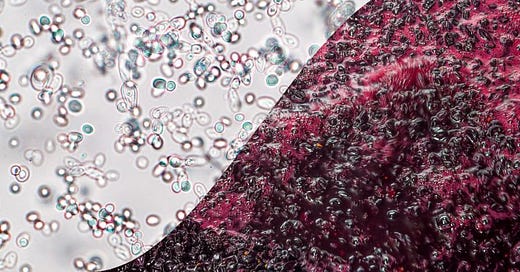Day 29 | The Role of Enzymes in Winemaking
From Naturally Occurring Reactions to Targeted Commercial Applications
Enzymes lie at the heart of winemaking, acting as biological catalysts for processes ranging from fermentation to flavor and color development. Many of these enzymes occur naturally in grapes and yeast, assisting in the breakdown of cell walls and the release of aromatic compounds. However, large commercial wineries—and increasingly some smaller producers—sometimes introduce exogenous enzyme preparations to optimize extraction, clarification, and overall efficiency. Opinions vary on the practice: while some view commercial enzymes as an effective means to ensure consistency, others question whether they dilute a wine’s sense of place or introduce an unnatural element.
Key Functions and Naturally Occurring Counterparts
Extraction Enhancement – Pectolytic enzymes (often present in grapes and yeast) help break down pectin structures, potentially improving color and aromatic intensity. Exogenous pectinases are sometimes added in larger-scale operations to achieve a more reliable or faster outcome.
Clarification Efficiency – Must settling relies partly on enzymes produced by yeast and present in grapes. Commercial formulations can accelerate this process, reducing the time required before fermentation begins or leading to clearer, more predictable fermentations.
Aromatic Release – Grapes contain bound aroma precursors that naturally occurring glycosidases help free. In certain aromatic varieties, exogenous enzyme additions may further amplify floral or fruity notes, though some question whether this risks overshadowing varietal typicity.
Practical Considerations
Scale and Consistency – Larger wineries may rely on exogenous enzymes for predictable results, particularly when processing high volumes where efficiency and reproducibility matter. Smaller producers sometimes take a more hands-off approach, relying on the vineyard’s natural enzymatic activity and the organismal complexity that arrives with the grapes.
Varietal Sensitivity – Different grapes respond uniquely. While fuller-bodied reds might tolerate higher levels of enzymatic activity without losing identity, delicate whites could show more pronounced shifts in aroma or mouthfeel.
Regulatory and Philosophical Debate – Some regions and countries permit commercial enzyme use with no reservations, while others deem it an excessive intervention that could standardize flavors. Labelling requirements for exogenous enzymes vary, prompting ongoing discussions about transparency in winemaking.
Potential Benefits and Caveats
Reduced Mechanical Intervention – Exogenous enzymes can minimize the need for forceful pressing or multiple rackings, potentially preserving subtle fruit nuances.
Over-Extraction Risks – Misapplication or excessive dosing might lead to harsher phenolics or unbalanced wines. Judicious use, guided by lab tests and tasting trials, remains paramount.
Natural vs. Commercial – Critics argue that commercial enzymes compromise terroir expression or tradition, while supporters view them as an accepted tool—comparable to nutrient additions or commercial yeast—in the broader scientific approach to modern winemaking.
Premium Subscriber Content
Keep reading with a 7-day free trial
Subscribe to Daily Terroir: Exploring Wine Regions One Day at a Time to keep reading this post and get 7 days of free access to the full post archives.





